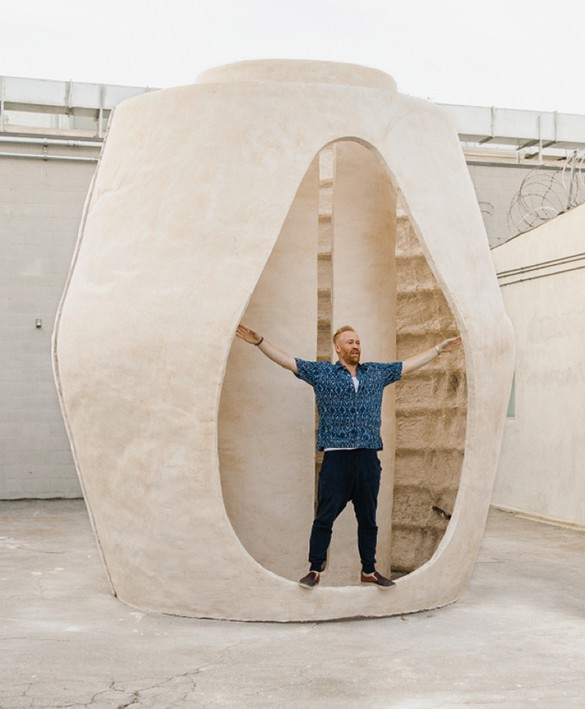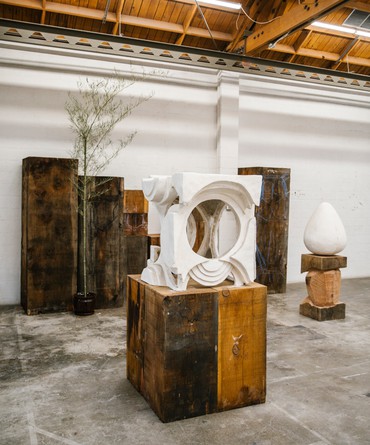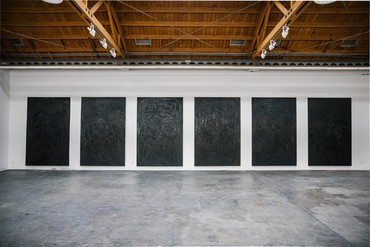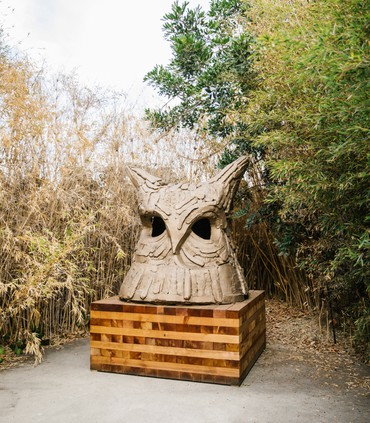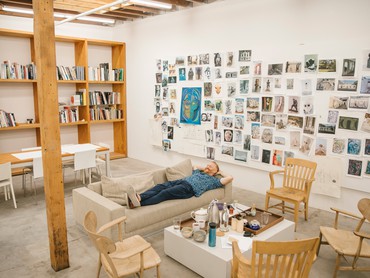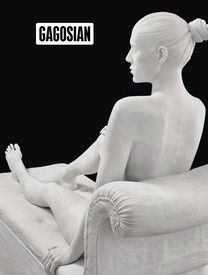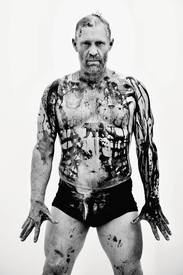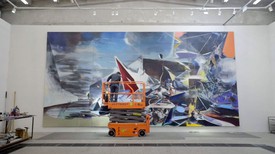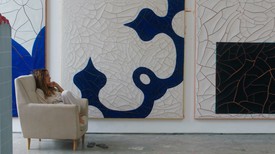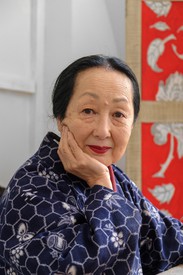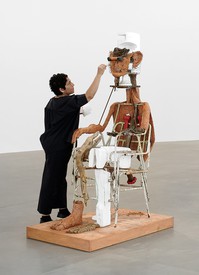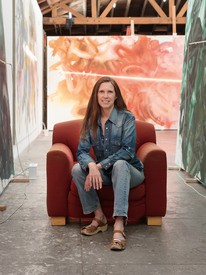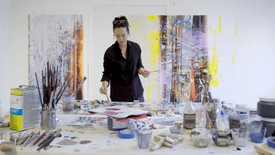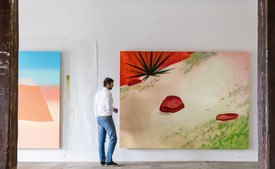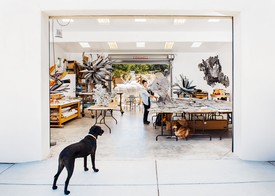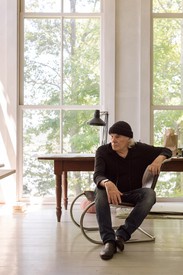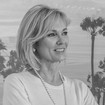
Deborah McLeod joined Gagosian as director of the Beverly Hills outpost in December 2005. In 2009, she oversaw the Richard Meier–designed expansion of the Beverly Hills gallery, doubling the footprint and adding an outdoor exhibition space. With an emphasis on both primary and secondary market sales, she oversees gallery operations, the exhibition program, and client service. She works closely with gallery artists Frank Gehry, Thomas Houseago, and the Chris Burden Estate. Photo: Joshua White/JWPictures.com
Deborah McLeodIn the studio there’s an artist, there are assistants, and there’s material being sculpted and changed and painted and made. You’re a maker, and you’re making, but you also seem to be allowing a spiritual flow to come into your practice, you’re open to what comes in the door.
Thomas HouseagoYeah, that’s true. There is a flow between what’s going on in the studio and in my life generally. Looking back, in some ways my work was a form of healing. In a lot of the work I did in the 1990s to early 2000s, I was almost in an automatic relationship with the object, where it was me and the object, me and the figure, me and the body, in a very tight gestalt, a very tight relationship. In my life I’ve tried to be more porous—I’m trying to have more of an easeful movement between my home, my role as a father, my role as a partner, my role as an artist. Those things used to be much more compartmentalized, much more tense. I’ve moved toward realizing that the kind of lone, creative, tortured individual that some artists are, I am sometimes—that’s reality, that’s part of me, it all depends on your nervous system, it all depends on your history—but I think I’m growing into a more open state about what an artist’s studio can be and what an artist can be, and then hopefully being able to radiate back out.
It’s funny, this election: we have this Trump presidency. I was talking with a friend, and I said “God, as an artist, what do we do? It’s so stupid sitting in this room making things out of clay.” And he said to me, “Hey, if you look at the electoral map, these big cities, New York, Chicago, and L.A., they were rejecting Trump, rejecting this kind of dialogue about America. These cities aren’t just economic centers, they’re cultural centers, and cultural thought, cultural activity, is part of social awareness. It’s part of a greater willingness to look at differences, at other ways of looking, other ways of thinking.” I was struck by that. New York is not just a financial trading center, LA’s not just Hollywood—they’re centers of culture and thought, they have histories of art, they have museums.
In a way the paintings we’re showing are painfully open about the difficulty of making an image, the difficult of making a painting, the difficulty of positioning myself in that process.
Thomas Houseago
DMI’ve been thinking a lot about the meaning of artists in our culture—they’re a radical voice in our culture and we need them more now than ever. Does that mantle ever feel heavy to you?
THNo, I actually have a different take on that. I think this election was largely decided by disaffected white males who work in close rural communities in the lower middle class. I grew up in that culture. It was a very transformative experience for me to go into art. When I was confronted by the range of options that white men have in British cities like Leeds and Liverpool, art was another whole dimension. It opened up another whole world. It really has taken me twenty years of investigation and thought and research and looking—
DMDid anybody in your family think you were Billy Elliott? I mean, was there resistance?
THNo, not at all. My mum and my father were both cultured people on some level. We had no money, we were broke, but my father listened to really good music, was a sort of odd guy, and had these strange books he would show me. My mum is also a very complex person. She’s interested in art and music; they listened to jazz and soul and reggae. I grew up in a very diverse population—Leeds has huge Jamaican, Indian, Bangladeshi, and Pakistani communities—so that was a very rich experience. I think people underestimate culture, they think it’s for the elite, the rich, for urban, educated people. I don’t think so: people relate to art and culture and music much more instinctively than we’ve been told. And I agree that art is radical, you’re absolutely right. There’s a great quote, “You can cause a revolution by painting an apple”: Cézanne painted an apple and caused a revolution in the way you look and the way you think about things. People are changed much more by thought processes, much more by pleasure, much more by questions, than they are by being told, or yelled at, or rallied in an angry way.
So I don’t see being an artist as a heavy burden. I think it’s an artist’s obligation to emotionally connect, good, bad, or ugly. There are works of mine that are almost like sculptures of the Trump psyche—it’s a cultural trope that’s been there forever.
DMSupermale.
THSupermale, but like the Cyclops supermale: the monstrous supermale that doesn’t think in a complex way, that is hurt, that is wounded, bullies. It’s fragile, ultimately. Creative, open, thoughtful, reaching-out discussion is the way forward. One of the dangers of capitalism and the way we have it right now in America is, everything is entertainment. Entertainment is fine but you also need enlightenment, you need to be challenged. If you just have a culture of shopping and entertainment, your field of view becomes very very small. Art has the ability to enlighten and awaken that consciousness. I really believe that.
Muna El FituriYour idea of the studio is also about trying to embrace the community. Your studio is set up to absorb children and animals and people who are just interested in looking. There’s that sense that it’s not the Thomas Houseago studio, it’s hopefully going toward being a much more open forum.
THLA is a very creative community. Musicians, filmmakers, architects, actors, younger artists—there’s a lot of energy here that if you’re open to it can be really enriching. I think because the city is so geographically pulled apart, we’ve found the studio is a good place to meet—to invite people over and to meet.
DMLike a salon, exchanging ideas?
THYeah, and discussing ideas from other zones of thought and activity. That’s becoming more and more important to me. There’s the great Courbet painting of the studio in the Musée d’Orsay, where painting and memory and the artist’s life have all merged. I love that idea of the studio being a merging of past and present, and the places you want to go, the fantasy world and the real world—a place able to transform the normal laws that occupy us in our normal lives when we go out in the world.
DMMaybe it’s time, to make the studio a hotbed of thought, where you invite astronomers and environmental scientists and singers and bass players. Historically, great ideas and movements are hatched this way, and we haven’t had that, because we’ve been in a hurry, but maybe we’re all going to slow down now.
THArtists and art spaces and museums and galleries, we’re all part of a complex phenomenon. You walk into an exhibition, you never really know what it’s about. You walk in and go “What is this?” It is an open-ended discussion. And of course there are artists who are doing real social activism—Mark Bradford, Theaster Gates—a lot of artists are embracing direct involvement in communities. That is an extremely important model. Rather than making more and more gilded spaces, I think we have to move out. Art should be in cities, art should be visible, it has to go out into the fabric of the world. There’s a huge need for that. Look at what Michael Heizer’s doing out in the desert, City: people don’t know about City, but everyone is fascinated. I’ve never met anyone who was indifferent to something like that. So it’s not indifference, it’s just that it’s not present enough. Art is about being reminded that certain things are possible.
Collaborations between artists and architects, architects and musicians—more of that needs to happen to have more successful experiences. With very little money you can have an extraordinary enlightening experience. It’s about communication and believing that it can happen. In fact certain modes of art are really successful in this regard: acting is an art, music is an art, theater is an art.
DMSome art is not as communicative, it’s hard work and people give up. But people love environments like Yayoi Kusama’s room of lights, Infinity Room, at The Broad, or your sculpture there, the colossal Cyclops. Christopher Knight wrote of that work, “Within its fifteen-foot-tall form, Thomas Houseago’s monumental bronze Giant Figure (Cyclops) collapses an ancient Greek kouros, a self-sacrificing Rodin Burgher of Calais, Michael Rennie’s clanking robot bodyguard, Gort, from The Day the Earth Stood Still, a child’s Transformer toy and more.” I thought that was fantastic.
THYes, that was great.
DMYou allow all these interpretations—all these things people see are legitimate views of your art.
THSome people have fixed ideas of what figuration should be: either it’s pure pop or it’s high, high heavy duty. I actually think it’s much more complicated than that. I really was pleased with that review because that is how you look at that figure, it’s real. That’s what looking is. We’ve been through a hybridization of what things look like. I don’t think you can look at the history of art without also being inflected with popular culture, science fiction, animation, advertisements, and all these things. The figure has morphed the same way that way culture has morphed and we’re still trying to figure out what it looks like, what we look like, what art should look like. Can you make figurative art? Sometimes I’m convinced I can’t anymore, and I’ve stopped. I’m not really making figurative statues anymore.
MEFBut they’re read as figurative, which brings out how your work resides in the tension of contradiction. That Cyclops is terrifying, but people love to take pictures between the legs. Ultimately there’s something pleasing about that work, it feels warm and embracing. A lot of your abstract works are quite figurative in a way. People refer to them in terms of people, things, animals.
THSculpture has the potential to do that. It’s both terrifying and reassuring at the same time because it’s giving form, it’s giving space, to these things we feel, these things we dream about, these fears. I believe this idea of manifesting things that don’t make sense, that don’t fit, that are odd, that are mixes, is really important for a society to function well. Christopher Knight mentioned Transformers, those robots, dolls—my generation came through that, it’s deep in our consciousness. And as you look at the history of the figure, or start looking at the way art has moved, there’s a much more troubling blurring than our historians would maybe like us to believe. I don’t think there’s linearity, I don’t think we’re progressing toward something, I think art goes back and forward and up and down. I don’t think the twentieth-century idea of we’re making progress, we’re getting better—that’s kind of a moralistic, elitist view and I don’t think art works that way, I think it moves and shapes and morphs and reflects and imprints. Where we have to be careful is when it doesn’t do that. When art starts only being reassuring and too easy to read is when you’re in trouble.
Art should be in cities, art should be visible, it has to go out into the fabric of the world.
Thomas Houseago
DMIn your thinking and creating process, what is generally the seed for a new work? I know you draw a lot, and drawing and thinking are very closely knitted together for you.
THThat’s a really interesting thing. There are periods when I’m looking at everything like a child will, I’m like a giant eyeball just taking it in. And then there periods where I’m drawing, points where there are forms and ideas and memories and things I’ve seen that I’m trying to make sense of. I’m almost mixing a soup at that moment. Then there are phases where I’m thinking a lot, listening to music a lot, looking at art, reading the news—I’m an avid news reader. I want to know what’s going on. Researching, I’m a big researcher. I’ll get really fascinated and that kind of bleeds in.
DMI know you’re a real student of art history, and it all works its way into the work.
THYes, but I think the process is mostly coming up against the world and making something that you feel is missing in the world, or making something for someone you love. And sometimes it’s just noticing, “Hey, how do I put form to this? How do I put form to these thoughts? How do I remind people of these possibilities?” As we move forward we have very stark choices: are we going to destroy the planet, are we going to destroy ourselves, are we going to be in endless war? Or are we going to move toward an awareness of our vulnerability, an awareness that we need to be making changes, that we need to be in an enlightened phase? I feel the potential of both. And I feel there are sculptures I’ve made that are really trying to emphasize that, to emphasize the idea of space as a magical entity that’s full of possibility and gives you numerous ways to look and think and feel and experience.
DMYour practice has taken a turn, and while you haven’t left figuration behind you’ve moved into this spatial area with the double abstracts, for example the Moun Room, which was at Rockefeller Center.
THThat was the first, yes.
DMI also see your practice as a bit yin and yang, masculine and feminine, figure, and site.
THYes, that’s totally right. The Rockefeller Masks was the beginning of wanting people to literally walk in and enter the sculpture—the sculpture became a kind of studio, going back to your idea that the studio feels porous. In a way, I’m kind of putting a studio out into the world. The Masks led to the Moun Room which led to the works in the Gagosian LA show, which are becoming more porous, more open-ended. The experience of being in the sculptures is changing—there isn’t one perspective, there isn’t one way to look at them, there isn’t even one way to enter them. They’re multifaceted.
DMYou offer people the chance to literally get into the work. You also show the front and the back—a lot of practices don’t allow that. And you reveal your process, people looking at your sculpture can see rebar, hemp, they can see process, they can see bits of plaster dangling. You really bare it.
THYes, I was discussing this with someone, we had this odd conversation about legacy—“How would you like your work to be when you die?” And the thought came up of something being completely unfinished. To some extent I think the idea of finishing a work, it being perfect and that’s it, that doesn’t interest me. I think getting better and missing is much more interesting to me than attaining some kind of idea of what an artwork should be.
DMYou don’t bury the process.
THNo, I want the process right out there. Normally, with all of my work, if you sit with it for a minute you’ll see exactly how it’s made. There’s no tricks, there’s no “How’d he do that?” If I spend a lot of time on it, I don’t care—I can make a really great piece in twenty minutes and I can make a really great piece in two years. And I’m not a skillful person, I don’t have craft. I think some of my best pieces come from a really unskilled place in me and in a way the paintings we’re showing are painfully open about the difficulty of making an image, the difficulty of making a painting, the difficulty of positioning myself in that process. Just the sad loneliness of being in the studio making paintings is a part of them. If you’re feeling emotionally open or you’re feeling strange about the world, being in the studio and mining yourself is a really brutal experience, and that’s in the paintings in a way. And I want to be able to do that, as well as have someone entering a sculpture be able to look at the sky through it, or look at other people through it.
DMWe have been talking about rhythm and the quality of life here, the feeling here, the meaning of art. Do you work every day?
THYes.
DMAnd do you come to the studio every day?
THNo.
DMAnd do you know what you’re going to do when you get here?
THSometimes yes, sometimes no. I like to have a plan, I feel very adrift and even scared if I don’t have a plan, but there are also months when it’s tremendously exciting coming in with no plan. I work every day, I’m always thinking about it, I’m always processing my life with work in mind. It kind of germinates, germinates, germinates, and then there are really exciting periods when there’s lots of physical activity. And the guys, the team I work with, we’re in it. We’re in the process of making a work and that’s its own kind of excitement. There’s a feeling of flux and energy. So there are different modes of work and there are different modes in which the studio activates.
DMThere’s solo work and there’s teamwork.
THRight, and nighttime work. I think the paintings came a lot from nighttime work.
DMWhen you’re alone and it’s dark.
THYes, alone. The night is a reassuring time for me, a quiet time. It’s usually a pretty great creative time for me.
DMDo you ever hate what you’re doing and say, “That’s it. I’m never coming to the studio again”?
THYes, regularly. All the time. There’s a constant battle between acting and not acting. Acting by its very nature is fraught with mistakes and the reality of doing it; and not acting is great because you can stay in your fantasy about your potential.
Muna El Fituri is a writer, translator, and art therapist currently residing in Los Angeles. As Houseago’s partner, his 2013–14 Moun Room is named after her.
Thomas Houseago: The Ridge, Gagosian, Beverly Hills, January 12–February 16, 2017; artwork © Thomas Houseago; photos: Nathaniel Wood, unless otherwise noted
